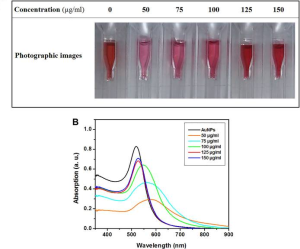A group from Faculty of Pharmacy, Tehran University of Medical Sciences, Tehran, Iran, etc. has reported about a Nanobiosensor based on H-1 antigen-Gold NanoParticles (AuNPs) aggregation detecting M1 Streptococcal Pharyngitis.
https://www.ncbi.nlm.nih.gov/pmc/articles/PMC9354983/
Streptococcus pyogenes (GAS) is a Gram positive bacterium that causes a wide variety of clinical conditions, ranging from acute pharyngitis to severe invasive diseases. A common method for the diagnosis of streptococcal pharyngitis is a physical examination by a physician and then a bacterial culture of throat swab. Until now, various types of biosensors were developed to diagnose GAS for clinical use. Those are based on antibody-antigen interactions, or on an isothermal nucleic acid amplification technology. Nevertheless, they are not widely used by clinicians worldwide, which may be related to the high cost.
The nanobiosensors based on the aggregation of AuNPs are well-known, and have been studied as an easy-to-use diagnosis of pathogens, where the presence of a specific antigen in a colloidal medium containing bioreceptor–AuNPs conjugates results in the aggregation of nanoparticles. Since it is known that M1 GAS binds to H-1 antigen, in this study, a sugar code present on oral epithelial cells, Lacto-N-fucopentaose I-biotin (H-1-biotin) was conjugated on avidin-AuNPs as an antigen to detect M1 GAS.
Based on the value of red-shift in SPR position, a calibration curve for detection of M1 GAS was plotted at a concentration range from 1 × 102 up to 1 × 107 CFU/ml. It was found that M1 GAS was detected in a wide concentration range (1 × 103 – 1×106 CFU/ml) with a linear response and a short detection time of 20 min.

